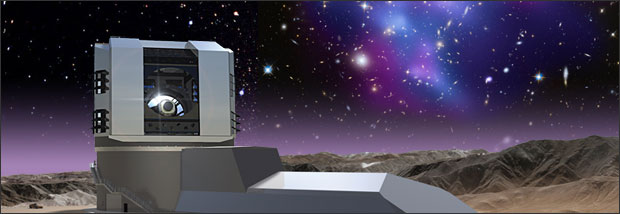Site Navigation
General Information
LSST: Providing an Unprecedented View of the Cosmos

A revolutionary 3.2 gigapixel camera mounted in a massive ground-based telescope will produce unprecedented views of the cosmos, driving discoveries with the widest, densest, and most complete images of our universe ever captured.
New Visions
The Large Synoptic Survey Telescope (LSST) will peer into space as no other telescope can. This new facility will create an unparalleled wide-field astronomical survey of our universe – wider and deeper in volume than all previous telescopes combined. The combination of a 3200 megapixel camera sensor array, a powerful supercomputer, a cutting-edge data processing and distribution network, and a massive telescope stationed on a mountaintop in Chile promises to cast light on mysteries fundamental to our understanding of the universe. From the distant signatures of dark energy to the dangers of near-earth asteroids, LSST will capture it all. Three central considerations dictated the design of LSST: wide, fast, and deep.

WIDE: A 3.5-degree field of view will produce a complete survey of the entire night sky every three days, an impossible task for a smaller device.

FAST: Rapid exposures of 15 seconds and the ability of the telescope to point and shoot every five seconds will chart the changes in space with 800 panoramic shots each night, tracking phenomena from the redshift at the edge of the universe to fast-moving asteroids closer to home.

DEEP: The sensitive camera array will ultimately image five billion galaxies, catching the subtle glow of the far-reaches of space in unprecedented detail.
Illuminating the Dark
The known forms of matter and types of energy
experienced here on Earth account for only 4 percent of
the universe. The remaining 96 percent, though central
to the history and future of the cosmos, remains
shrouded in mystery. Two tremendous unknowns present one
of the most tantalizing and essential questions in
physics: What are dark energy and dark matter? LSST aims
to expose both.
Dark Energy: Something is driving the
universe apart, accelerating the expansion begun by the
Big Bang. This force accounts for 70 percent of the
cosmos, yet is invisible and can only be “seen” by its
effects on space. Because LSST is able to track cosmic
movements over time, its images will provide some of the
most precise measurements ever of our universe’s
inflation. Light appears to stretch at the distant edges
of space, a phenomenon known as redshift, and LSST may
offer the key to understanding the cosmic anti-gravity
behind it.
Dark Matter: Einstein deduced that massive objects in the universe bend the path of light passing nearby, proving the curvature of space. One way of observing the invisible presence of dark matter is examining the way its heavy mass bends the light from distant stars. This technique is known as gravitational lensing. The extreme sensitivity of the LSST, as well as its wide field of view, will help assemble comprehensive data on these gravitational lenses, offering key clues to the presence of dark matter. The dense and mysterious substance acts as a kind of galactic glue, and it accounts for 25 percent of the universe.
An Interactive Motion Picture
From its mountaintop site, LSST will image the entire visible sky every few nights, capturing changes over time from seconds to years. Ultimately, after 10 years of observation, a stunning time-lapse movie of the universe will be created.
As the LSST stitches together thousands of images of billions of galaxies, it will process and upload that information for applications beyond pure research. Frequent and real time updates – 100 thousand a night – announcing the drift of a planet or the flicker of a dying star will be made available to both research institutions and interested astronomers.
In conjunction with platforms such as Google Earth, LSST will build a 3D virtual map of the cosmos, allowing the public to fly through space from the comfort of home.
Get the latest updates and learn more at LSST.org

A rendering of the LSST, an 8.4-meter ground-based telescope that will survey the entire visible sky deeply in six broad optical bands over the main survey area of 18,000 square degrees.





